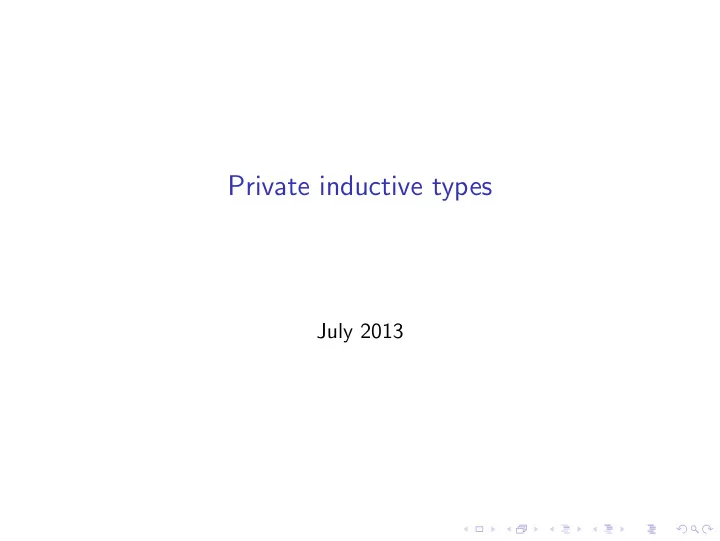

Private inductive types July 2013
Introduction ◮ Higher Inductive types: adding equalities ◮ Preventing inconsistencies ◮ Preserving convertibility ◮ Simulating with private types
What is this thing called Equality ◮ A family of equality types: for x y : A , x = y is a type ◮ Described as an inductive type: no specific treatment ◮ Induction principle illuminating ∀ A : Type . ∀ x : A . ∀ P : A → Prop . P ( x ) ⇒ ∀ y : A . x = y ⇒ P ( y ) ◮ If x = y then every property satisfied by x is also satisfied by y ◮ x and y are undistinguishable ◮ Are they really?
using a magnifying glass ◮ Say that when x = y , then x and y are not really the same for all purposes ◮ So x = y should only mean there is a path between x and y ◮ Distinction at a microscopic level ◮ But at the macroscopic level, still x and y are equal.
Build new objects with paths between them ◮ State at the same time the creation of objects and the property that they are identical. ◮ Example: assert the existence of two points N and S and two paths between them. ◮ Already done easily for points using inductive types ◮ What about the paths? ◮ Natural to add paths as axioms
Inconsistencies with axiomatic paths ◮ Usual interpretation of equality (identity) types ◮ Ultimately only one way to build proofs of equality: reflexivity ◮ No confusion property of inductive types ◮ Rely on strong elimination ◮ Axiomatic paths between constructors incompatible with no-confusion
Illustration Inductive cellc := N | S. Axiom west : N = S. Axiom east : N = S. ◮ Obviously inconsistent in plain Coq.
Preventing inconsistency ◮ Allow only to define function that preserve path consistency ◮ In illustration, f N and f S must have a path between them. ◮ Also take into account dependent types ◮ Solution already easy to implement in Agda
Heavy solution ◮ Avoid inductive types ◮ State axioms for all elements of the higher inductive type
Illustrating the heavy solution Parameters (cellc : Type) (N S : cellc). Axioms west east : N = S. Parameter cellc_rect (P : cellc -> Type) (vn : P N) (vs : P S) (pw : eq_rect N P vn S west = vs) (pe : eq_rect N P vn S east = vs) (x : cellc) : P x. Axiom cellc_rect_N := forall P vn vs pw pe, cellc_rect P vn vs pw pe N = vn. Axiom cellc_rect_S := forall P vn vs pw pe, cellc_rect P vn vs pw pe S = vs.
What’s wrong with being heavy? ◮ Provably equal is not convertible ◮ cellc rect P vn vs pw pe N and vn are not convertible ◮ More uses of eq rect are required everywhere ◮ The size of proofs increases drastically
Adding convertibility ◮ Come back to inductive types ◮ Design elimination function to enforce guarantees Definition cellc_rect (P : cellc -> Type) (vn : P N) (vs : P S) (pw : eq_rect N P vn S west = vs) (pe : eq_rect N P vn S east = vs) (x : cellc) := match x return P x with N => vn | S => vs end.
Computing with cellc rect ◮ cellc rect P vn vs pw pe N and vn are now convertible ◮ Okay if the only functions definable in Coq have to be defined using cellc rect . ◮ Need to forbid direct use of pattern-matching, tactics case , discriminate , inversion , injection . . .
Idea of private types ◮ In a module, define an inductive type to be private ◮ Inside module: unsafe operations, trusting the programmer ◮ Outside module: more safety, only functions provided by module designer ◮ Preserve computation (convertibility) for functions provided in the module ◮ No modification of the kernel, only module handling ◮ Deactivate tactics and syntax ◮ Hard questions about consistency: not treated by the kernel
Simulating the circle inductive type Module Circle. Local Inductive Circle := N | S. Axiom east : N = S. Axiom west : N = S. Definition circle_induction (A : Type)(vn : A)(vs : A) (epd : vn = vs)(wpd : vn = vs)(x : circle) : A := match x with N => vn | S => vs end. Axiom circle_induction_cws : forall A vn vs epd wpd, ap (circle_induction vn vs epd wpd) east_side = epd. End Circle.
Conclusion ◮ Potential inconsistency comes from adding axioms ◮ Idea of private types orthogonal to axioms ◮ Application outside homotopy theory are probable
Recommend
More recommend